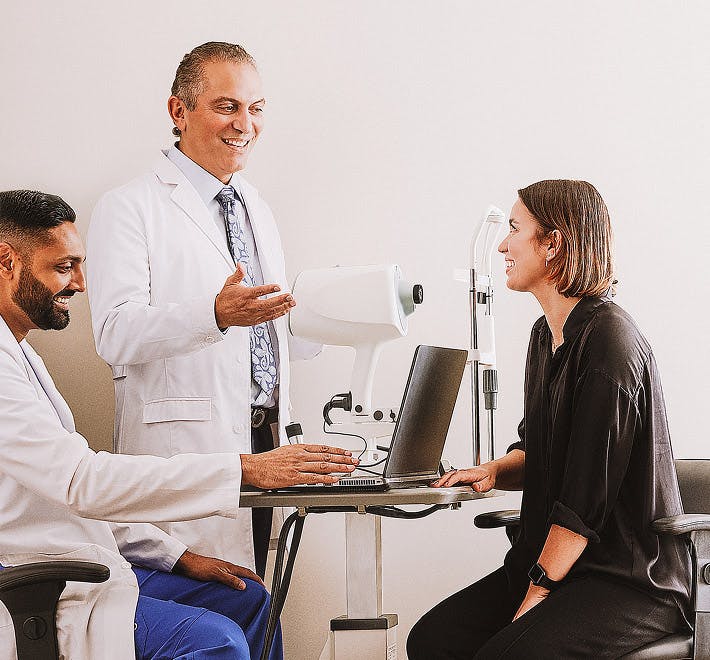Cataract surgery has transformed millions of lives, restoring vision and independence to people around the world. Today, patients aren’t just asking when to have surgery—they want to know about their lens options. Multifocal intraocular lenses (IOLs) have set a high bar, but now a new generation of accommodating lenses is in development.
The question many patients ask is: Are these new lenses worth waiting for?
This article breaks down what’s available now, what’s coming next, and whether waiting makes sense for you.
Prefer video? Watch my full discussion here: Cataract Surgery Breakthrough: Multifocals vs. Accommodating Lenses.
What Is Cataract Surgery?
A cataract occurs when your natural lens becomes cloudy, gradually blurring vision and making daily tasks difficult. The only treatment is surgery, where the cloudy lens is removed and replaced with a clear artificial lens, called an intraocular lens (IOL).
During cataract surgery:
- A small incision is made in the eye.
- The cloudy lens is broken up and removed.
- A new lens implant is inserted into the capsule—the thin, clear “bag” that held your natural lens.
This procedure is one of the safest and most effective surgeries performed today, with success rates exceeding 98%.
The Types of Lenses Available Today
For decades, cataract surgery used only monofocal lenses. These provide excellent clarity, but focus at only one distance, so glasses are still needed.
In the last 15 years, multifocal lenses have become increasingly popular. They split light into different focal points, giving patients the ability to see near, intermediate, and far.
However, multifocals have some limitations:
- They split light, which can cause halos around lights at night.
- Contrast may be slightly reduced, especially in dim conditions.
- Patients with macular degeneration or other retinal problems are not ideal candidates.
These drawbacks are why accommodating lenses are generating so much excitement—they could restore natural focus without splitting light.
What Are Accommodating Lenses?
When you’re young, your natural lens flexes to shift focus from distance to near. This is called accommodation. As we age, the lens stiffens and eventually becomes cloudy, leading to presbyopia and cataracts.
Accommodating lenses are designed to restore that youthful flexibility. Instead of splitting light like multifocals, they move or change shape to direct all light to the desired focus point.
Potential advantages include:
- Better contrast sensitivity (especially in dim light).
- Fewer halos and glare at night.
- More natural, seamless focus at all distances.
Challenges of Accommodating Lens Technology
Despite their promise, accommodating lenses face real challenges:
- Power Prediction: Moving lenses complicate the formulas surgeons use to predict vision outcomes.
- Capsule Behavior: Post-surgical healing can cause the capsule to shrink, limiting the lens’s movement.
- Sizing & Placement: Precise fit is essential, and each design requires different positioning inside the eye.
- Surgical Workflow: Some designs require more steps, time, or specialized tools, which can increase complexity and cost.
The 8 Leading Accommodating Lenses in Development
- Juvene – LensGen (USA): A modular, two-piece lens that fills the capsule. Clinical studies show consistent vision at all distances and monofocal-like contrast.
- OmniVu – Atia Vision (USA): Recently approved for U.S. trials. Early human data shows accurate focusing and a smooth visual range.
- FluidVision – Alcon (USA/Switzerland): Uses fluid to simulate natural lens movement. Early trials show real accommodation (approx. 2.2 diopters).
- Lumina – Akkolens (Netherlands): CE-approved in Europe. Offers functional near and distance vision with good contrast.
- Opira – ForSight Vision6 (USA): Anchors in front of the capsule. Two-year data shows better near/intermediate vision than monofocal lenses.
- JelliSee IOL – JelliSee (Israel/USA): May benefit from capsule fibrosis rather than be harmed by it. Small trials show up to 7 diopters of accommodative range.
- Ocumetics Accommodating Lens – Ocumetics (Canada): First-in-human trial began in 2025. No clinical data yet published.
- Elenza Sapphire Autofocal – Elenza (USA): A futuristic design using liquid-crystal technology and a rechargeable battery. Still in early development.
Which Lens Looks Most Promising?
Soonest to Market: Lumina, which already has CE approval and is being used in Europe.
Most Promising in U.S.: Juvene and OmniVu—both preserve monofocal-level image quality and offer a continuous range of vision.
Should You Wait?
- If your cataracts are mild: You can wait and monitor. New technologies may be available in 5–10 years.
- If cataracts are affecting your safety or lifestyle: Don’t delay. Today’s lenses already deliver excellent outcomes when properly chosen.
For patients with retinal conditions, monofocal lenses remain the safest and most effective choice.
What to Expect from First-Generation Accommodating Lenses
First-generation technologies often come with trade-offs. Early multifocals had issues with halos and contrast, but improved with each new release. Expect the same here:
- Higher variability in power prediction
- Initial workflow complexity
- Higher cost at launch
- Rapid improvements with 2nd and 3rd generation models
Key Takeaways
- Accommodating lenses aim to mimic the natural focusing ability of the youthful eye.
- They may offer fewer night halos and better contrast than multifocals.
- Clinical trials are ongoing; broad U.S. availability may take 5–10 years.
- Excellent lens options are already available for patients needing surgery now.
👉 Watch the full video breakdown here: Cataract Surgery Breakthrough: Multifocals vs. Accommodating Lenses
FAQs About Cataract Surgery and New Lenses
- What is the success rate of cataract surgery?
Cataract surgery has a success rate over 98% when performed by experienced surgeons.
- Are multifocal lenses safe?
Yes. While some patients report halos or glare, most adjust well and enjoy reduced dependence on glasses.
- How long until accommodating lenses are routine?
Experts estimate 5–10 years for widespread U.S. use. Europe may adopt them sooner.
- Should I wait for them?
If your vision is stable, you can wait. But if cataracts are affecting quality of life, don’t delay treatment.
- Where can I learn more?
Visit our page on Cataract Surgery in New York City for details.




